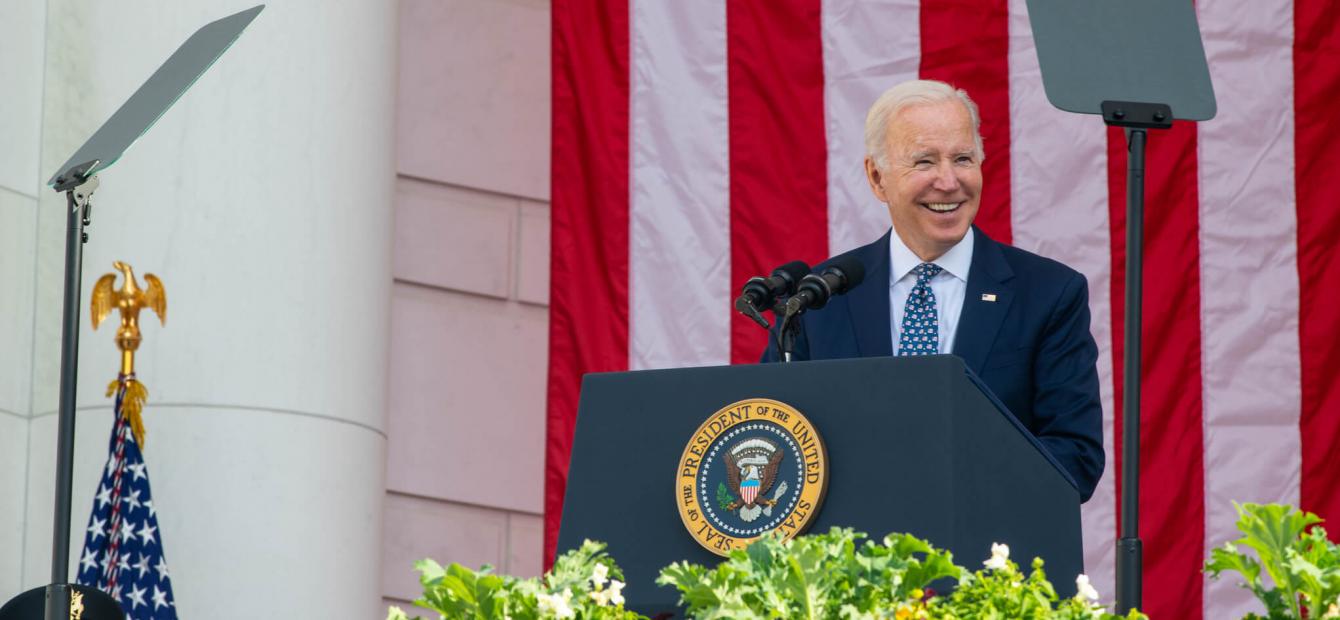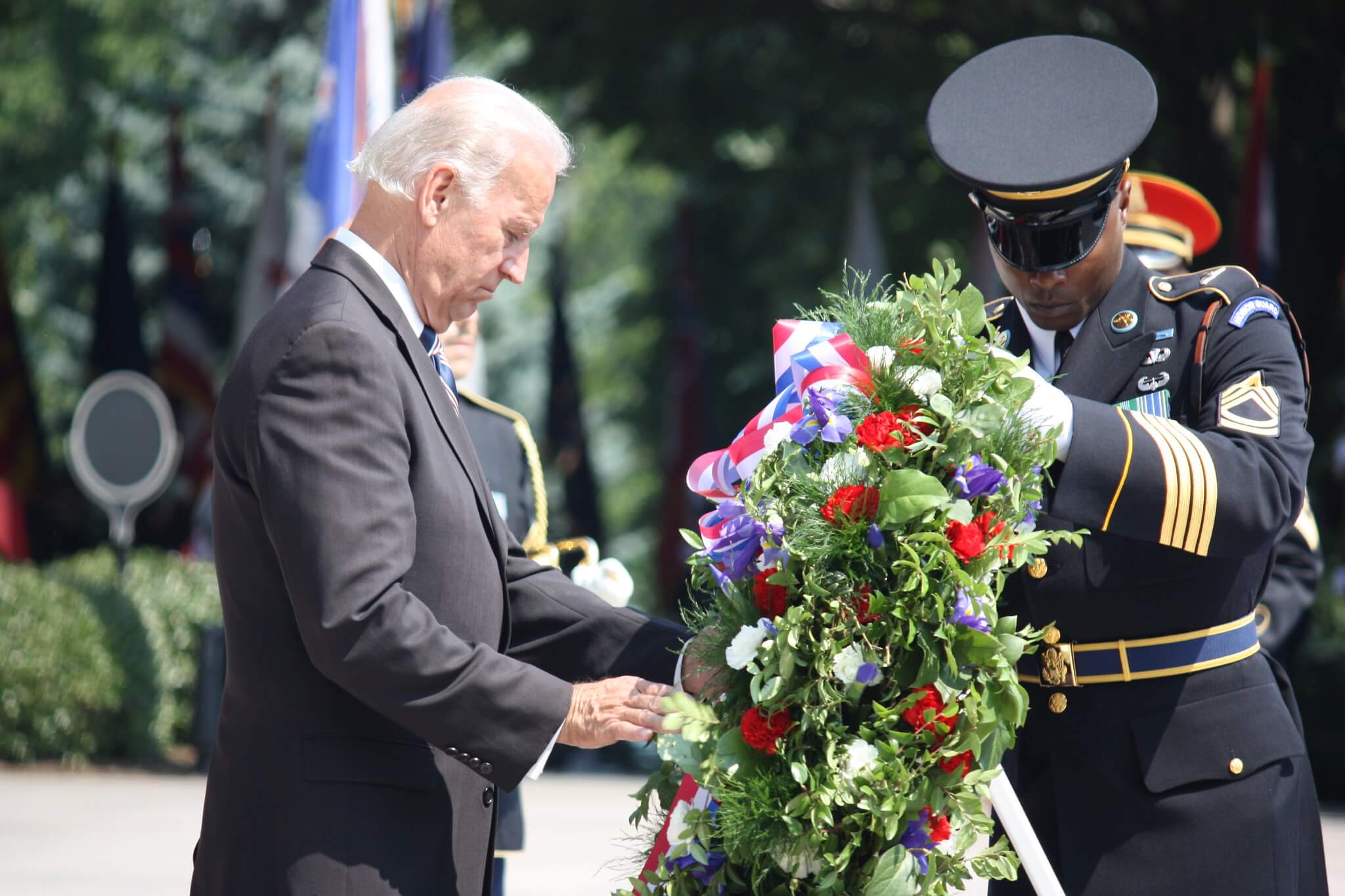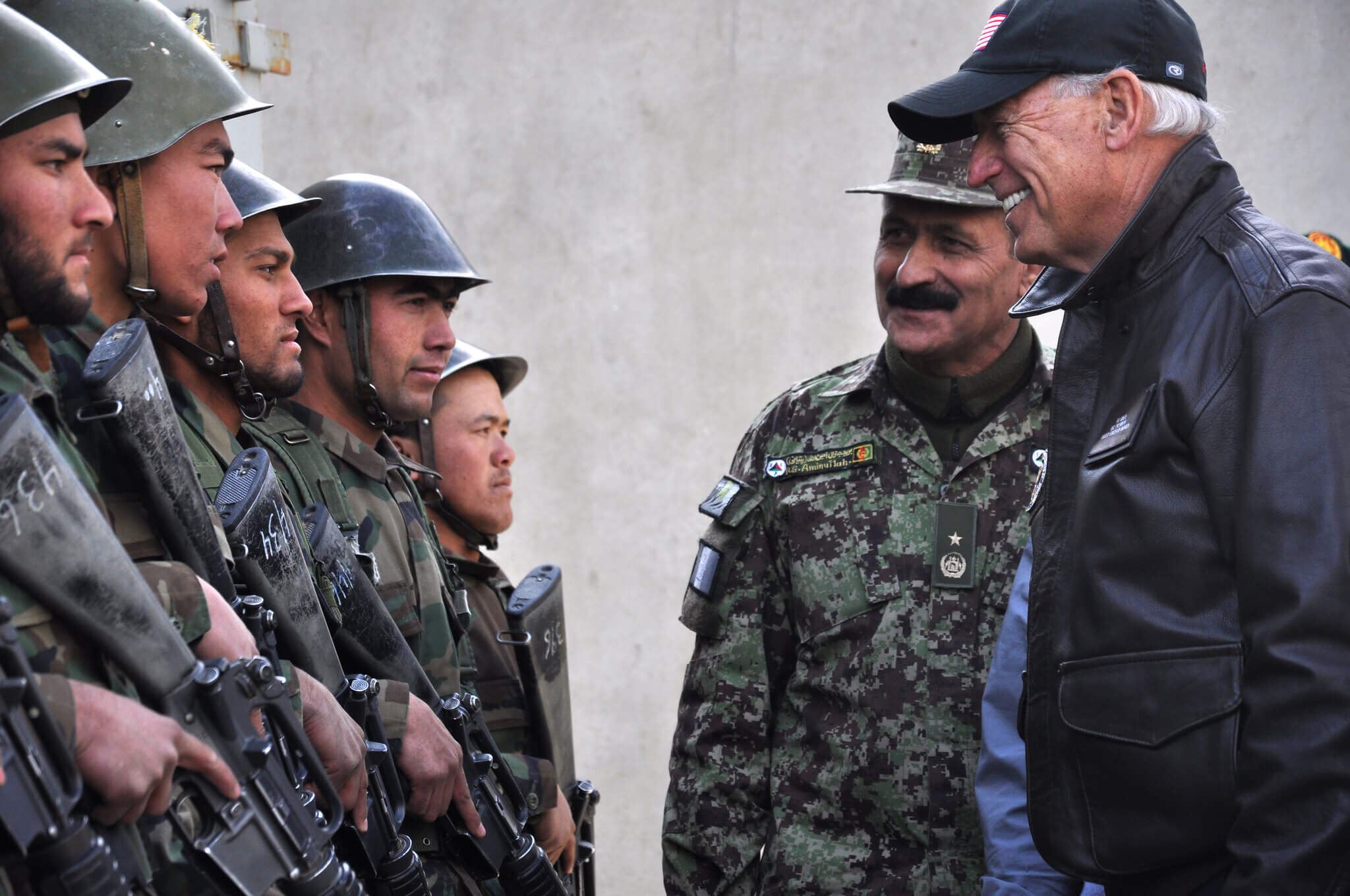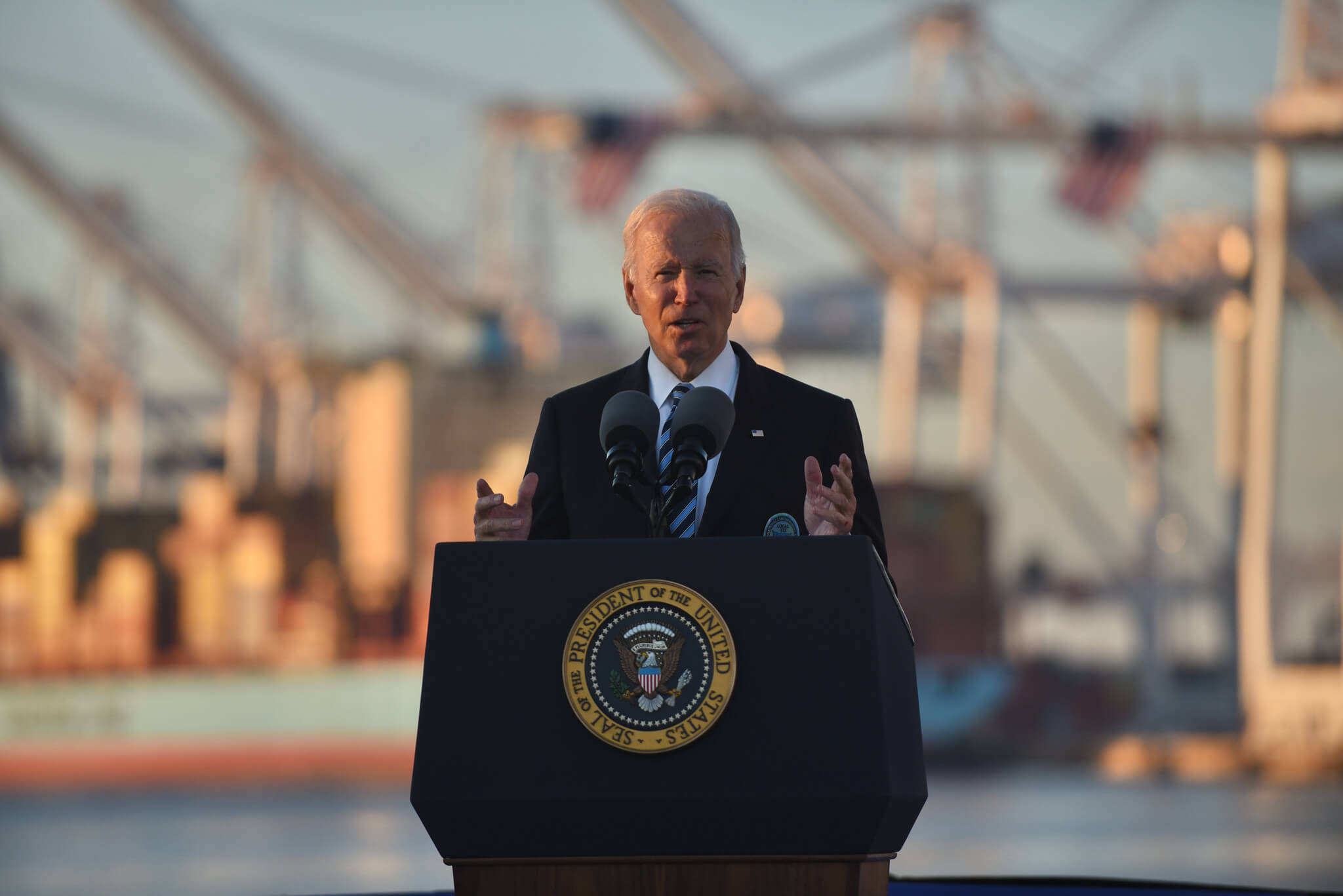
Biden’s first year: Saving America’s image?
On 20 January, it will be one year since the inauguration of Joe Biden as the 46th president of the United States. A year into his presidency, it is time to take stock and ask whether Biden has lived up to his promise to improve America’s reputation around the world. In this article, Nick Cull (University of Southern California) examines the role of public diplomacy, and concludes that we should not expect a ‘Biden bounce’ anytime soon.
Among the many deficits of Donald Trump’s presidency was the damage that his personal and political behaviour did to the image of the United States around the world. All major polls, including the Pew Global Attitudes survey and the Anholt IPSOS Nation Brands Index, reported a significant sinking in the reputation of the US during the Trump years.1
Trump’s perceived mishandling of the COVID-19 pandemic confirmed the trend.2 Restoring the standing of the US promised to be a major task for his successor, made more urgent by the return of great power competition to the fore of international life.
By 2020, and long before, it was obvious that with both China and Russia investing heavily in international media and aggressive messaging, international images and narratives had been weaponised at a level unseen since the height of the Cold War. Trump’s successor faced a world in which reputation was once again a dimension of security and a leader’s performance in that regard had become a critical dimension of statecraft.3
The Biden bounce
The nomination of Joe Biden seemed like a step in the right direction and held for many the promise of a ‘Biden bounce’ back to widespread admiration for the United States around the world. Biden seemed like a promising president to rebuild America’s standing abroad.
His career as chair of the Senate Foreign Relations Committee reflected a deep knowledge of foreign policy issues. Furthermore, his past engagement with issues of America’s image included sustained support for such key instruments of US image making as US-government funded broadcasters Radio Free Europe/Radio Liberty (incorporated in his home state of Delaware).4
Following his electoral victory, Biden’s inaugural address explicitly promised a foreign policy attuned to the notion of soft power. Reworking a favourite formulation of Bill Clinton, Biden declared: “We'll lead not merely by the example of our power, but by the power of our example.”5
The world understood that the problems within the US revealed during the Trump years were deeper seated than one man’s eccentricities
The reputation of the US: volatile attitudes
One feature of national reputations is their remarkable stability. Most people around the world think little about other countries, hence once they have formed an opinion about a country, they tend not to adjust it.
The US is an exception to this. Its salience in lives around the world is such that attitudes to the United States are somewhat volatile. The data accumulated by the Anholt index is instructive to demonstrate this.
During the Iraq War of the early 2000s, Anholt found that the US remained in the middle of the top ten world powers. The election of Barack Obama in 2008 bounced the United States into the first place. The Trump years saw a slide into tenth position, which flowed from a weakness in both international perception of US governance and of the US public.
The only compensation was an even greater fall in the standing of China, which decreased from a position in the mid-20s into the mid-30s on the back of perceived mishandling of the COVID-19 pandemic.

Data gathered in 2021 promised to give immediate feedback on the extent to which Biden had made a difference. Polls taken in the summer of 2021 by both Pew and Anholt-IPSOS show only a modest recovery for the US. Anholt (researched in the summer and published in October 2021) placed the US at number eight, far short of the miraculous recovery associated with Obama.
Biden’s foreign policy includes some high-profile gestures to recommit the United States to a multilateral approach
This evidence suggests clearly that the world understood that the problems within the US revealed during the Trump years were deeper seated than one man’s eccentricities. The political divisions that had boosted Trump’s rise, the racial strife and other social issues all remained unresolved and posed a challenge to would-be admirers of the US.6
In keeping with these findings, Pew found that majorities around the world no longer see the US as a good example of democratic practice.7 In the presence of these alarming indicators, we should ask whether the Biden administration has moved effectively to begin correcting the problems? The answer is mixed.
Biden’s foreign policy includes some high-profile gestures to recommit the United States to a multilateral approach. The re-joining of the Paris Climate Accords which Biden initiated on his first day in office is an example of this.8 His new Secretary of State, Antony Blinken, has a track record of support for alliances and had previously stressed the value of public diplomacy.9
The US withdrawal from Afghanistan in August 2021, in contrast, shows a lack of concern for optics or coordination with allies and was self-consciously consistent with Trump-era policy.

Responding to the mounting challenges to human rights around the world, Biden moved to assert a symbolic leadership of democracy by scheduling a virtual summit on democracy for December 2021. Prominent allies who fail to uphold expected standards of human rights – including Saudi Arabia and the United Arab Emirates – were not invited.10
Yet, what of the tools of US public diplomacy: the mechanisms of listening, advocacy, culture, exchange and broadcasting that the US has historically used to engage foreign publics in its quest to advance its foreign policy goals?
The Trump years: A dispiriting time for US public diplomacy
For practitioners of US public diplomacy, the Trump years were a dispiriting time. Even diplomats who voted for him understood the damage done by President Trump’s speaking of taking care of ‘America First’, crudely comparing African countries to toilets and other unusual moves.
The Trump years saw a merger of the two core elements of public diplomacy within the State Department
Interestingly, however, the transition to Trump did not see the suspension of all public diplomacy programs and a pause for instructions from the top seen with the election of Obama. Rather, most posts pressed ahead with programs they knew to work well and hoped that they would fly under the political radar.11
The most serious threat to the actual operation of US public diplomacy was not administrative, but financial. An early Trump budget threatened to drastically cut funding to the crown jewels of US public diplomacy: the Fulbright and other exchange programs. Yet, a bipartisan group of legislators rallied to keep the funds flowing.
Still, President Trump embraced some aspects of public diplomacy. He, for example, proved an enthusiast for international expositions with the world-class pavilion for World Expo 2020 Dubai.12
Even more significantly, the Trump years saw a merger of the two core elements of public diplomacy within the State Department, addressing a dysfunction that had been obvious for some time but which other administrations had been shy to confront.
The timing was testament to the recognition of the increased threat in information space from Russia and China. The domestic facing Public Affairs Bureau and the outward facing International Information Programs jointly formed the Global Public Affairs bureau (GPA). It was the first major attempt at fixing the infrastructure of public diplomacy since the notoriously counterproductive merger of the Cold War home of US public diplomacy – the United States Information Agency (USIA) – into the State Department in 1999.13
The relative protection of US international broadcasting from mismanagement changed in Trump’s final year. His nominee for the Agency for Global Media, Michael Pack, finally took the helm in June 2020 and proceeded to suspend a swathe of senior personnel and moved to politicise the output of Voice of America (VOA), the largest and oldest US-funded international broadcaster.
The scale of information warfare from Russia and China now justified the reestablishment of an equivalent to the Cold War public diplomacy agency USIA
Thirty journalists lost their jobs for alleged political bias, which for those foreign language specialists hired abroad meant losing their right to remain in the US. VOA staff fought back in the courts and a court in New York emphatically reasserted the tradition of VOA news as being above partisan politics. This led to a reinstatement of managers as the Trump administration left office. The affair underlined the need for clearer boundaries and firewalls to protect US public diplomacy and state-funded journalism.14
Public diplomacy in Biden’s era: The best next move
In the early months of the Biden administration, diplomats and specialists in public diplomacy discussed the best next move. Some external observers opined that the scale of information warfare from Russia and China now justified the reestablishment of an equivalent to the Cold War public diplomacy agency USIA.
This was justified on the grounds that the agency had done a good job of rebutting disinformation in the 1980s. That part was correct, but none of the advocates of recreating USIA seemed well informed about the struggles of the agency at many other points and its ongoing difficulty impacting policy formation. There was no easy answer on the table.15
A group of policy analysts and young officers from within the Department of State provided a report for the Atlantic Council, an American think tank, called ‘Upgrading US Public Diplomacy’. They recommended a mix of steps to empower clearer leadership, build better campaign design, improve support for staff overseas and develop a greater understanding of public diplomacy at home.16

Of these recommendations, it was only the renewal of public diplomacy’s domestic dimension that seemed to chime with existing policies of Biden. The spectacle of the attack on the US capitol in January 2021 was one of many examples of a weak domestic base for the international ideology of democracy and law projected externally by the US.
In August 2021, Secretary of State Blinken declared that “domestic renewal” was a priority of US foreign policy. However, his emphasis was on rebuilding the infrastructure of US prosperity rather than revitalising a hinterland for US public diplomacy.17
Biden failed to nominate anyone to the most senior public diplomacy role
While the Biden-era budget did not promise the outright pain of his predecessor’s assault on funding for Fulbright, public diplomacy needs more than mere continuation. Most seriously, public diplomacy needs effective leadership and the White House has proved slow to even attempt to fill the key leadership posts in public diplomacy.
It was only as his first year in office concluded in November 2021 that Biden nominated a CEO for the Agency for Global Media. By choosing the former director of Voice of America, Amanda Bennett, he endorsed that station’s status quo.18
Biden failed to nominate anyone to the most senior public diplomacy role of Under Secretary of State for Public Diplomacy and Public Affairs (designated in State Department jargon by the initial ‘R’). Sadly, this is not unusual.
As analyst and former broadcasting governor Matthew Armstrong has pointed out, the role of R has been vacant for 40 per cent of the time, which ever party is in office.19 This is not usual in Washington DC and is a clear indication that public diplomacy is not a serious priority for this administration or any since the latter days of George W. Bush.
The need to rebuild America’s image
Does this neglect of public diplomacy matter? Information about the United States is so ubiquitous that the US government can only ever hope to actively curate a small corner of it. Moreover, even with Trump in office, the US was still regarded as a world leader and more admirable than its strategic rivals China and Russia, just less admirable than comparable democracies.
Unfortunately, the weaknesses in the image of the US are serious. The association of the country with the image of democracy around the world means that when the US falters, the successes of certain democratic middle powers in delivering stable transitions, management of differences and sane responses to crises like the COVID-19 pandemic cannot outweigh the spectacular failures of the self-proclaimed flagship of global democracy. The countries peddling an authoritarian alternative rejoice.
The country needs to both invest in telling the story more effectively and building a better story to tell
Yet, the need to rebuild America’s image should function as an impetus not just to speak more effectively but also to work at home for actual change. Public diplomacy can be the connective tissue in such a process.
One forgotten achievement of the United States Information Agency in the Cold War was listening to world opinion and by reporting to the White House, applying pressure on former presidents Dwight D. Eisenhower and John F. Kennedy to advance civil rights. Both of these presidents understood that the United States could not credibly champion democracy without addressing its domestic racism.
The same is true today. Improving the US image matters, but the country needs to both invest in telling the story more effectively and building a better story to tell. The bottom line: do not expect a Biden bounce any time soon.
- 1Richard Wike, ‘The Trump era has seen a decline in America’s global reputation’, Pew Research Center, 19 November 2020; Jason McGrath & Uri Farkas, ‘Germany retains top “Nation Brand” ranking, the UK emerges ahead of Canada to round out the top three’, Ipsos, 27 October 2020.
- 2Richard Wike, Janell Fetterolf &Mara Mordecai, U.S. Image Plummets Internationally as Most Say Country Has Handled Coronavirus Badly, Pew Research Center, 15 September 2020.
- 3The concept of Reputational Security is fully developed in Nicholas J. Cull, ‘From Soft Power to Reputational Security: Rethinking Public Diplomacy and Cultural Diplomacy for a dangerous age,’ chapter 34 of B.J.C. McKercher (ed.) The Routledge Handbook of Diplomacy and Statecraft, 2nd edition. London: Routledge, 2022.
- 4For a survey of public diplomacy in the 1990s including Biden’s role see Nicholas J. Cull, The Decline and Fall of the United States Information Agency: American Public Diplomacy, 1989-2001, London: Palgrave, 2012.
- 5The White House, ‘Inaugural Address by President Joseph R. Biden, Jr.’ Speeches and Remarks, 20 January 2020.
- 6Jason McGrath & Moriya Frankel, ‘Germany maintains top “nation brand” ranking, Canada and Japan overtake the UK to round out the top three’, Ipsos, 19 October 2021.
- 7Richard Wike, Laura Silver, Janell Fetterolf, Christine Huang & J.J. Moncus, ‘What People Around the World Like – and Dislike – About American Society and Politics’, Pew Research Centrer, 1 November 2021.
- 8Antony J Blinken, ‘The United States Officially Rejoins the Paris Agreement’, US Department of State, 19 February 2021.
- 9For Blinken’s historic support for public diplomacy see Antony J Blinken, ‘Winning the War of Ideas,’ The Washington Quarterly, Vol. 25, no, 2, June 2002: 101–114.
- 10Joseph R. Biden, ‘The Summit for Democracy’, US Department of State, February 2021.
- 11This was for example especially obvious in the area of international broadcasting with the highly political nomination of a CEO for the Agency for Global Media: the conservative documentary filmmaker named Michael Pack. His task was to oversee Voice of America – the largest and oldest US-funded international broadcaster – and its stablemates, yet his nomination remained just a nomination for several years. In the interim, Voice of America continued to deliver both good and bad news about the United States and the wider world.
- 12Funding remained an obstacle with the impressive Dubai pavilion ultimately being funded by a donor in that country rather than the hoped-for US donations.
- 13This paragraph is based on the author’s own conversations with US public diplomats in the field.
- 14Paul Farhi, ‘Controversial head of Voice of America resigns hours after President Biden takes office’, The Washington Post, 20 January 2021.
- 15On USIA see: Evan Cooper & Robert A. Manning, ‘How to fix the US public diplomacy deficit: Restore USIA’, The Hill, 13 February 2021; Shay Katiri, ‘It’s Time to Bring Back USIA’, The Bulwark, 21 July 2021.For rebuttal see: Mountainrunner, ‘The Irony of Misinformation and USIA’, 3 August 2021.
- 16Marta Churella, Wren Elhai, Amirah Ismail, Naima Green-Riley, Graham Lampa, Molly Moran, Jeff Ridenour, Dan Spokojny, and Megan Tetrick, ‘Upgrading US public diplomacy: A new approach for the age of memes and disinformation’, Atlantic Council, 15 September 2021.
- 17Antony J. Blinken, ‘Domestic Renewal as a Foreign Policy Priority’, US Department of State, 9 August 2021.
- 18Paul Farhi, ‘Biden favorite to run Voice of America parent agency could face trouble with Senate GOP’, The Washington Post, 28 October 2021.
- 19Mountainrunner, ‘W(h)ither R: a marquee failure of leadership in foreign policy’, 8 June 2021








0 Reacties
Reactie toevoegen